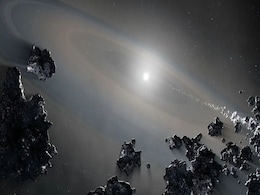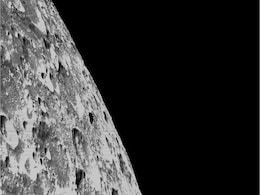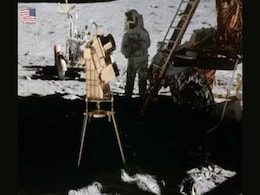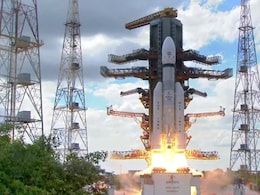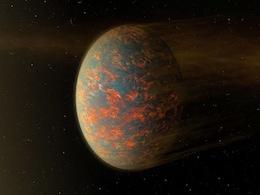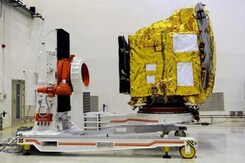Planetary Mission
- All
- News
- Videos
-

Earth’s Atmosphere Has Been Leaking Onto the Moon for Billions of Years, Study Finds
- Tuesday December 16, 2025
Earth’s atmosphere has been leaking atoms and molecules to the moon for billions of years, preserving a historical record and potential resources for future lunar missions.
-
 www.gadgets360.com
www.gadgets360.com
-

Uranus and Neptune May Be Rock-Dominated Planets, Study Suggests
- Saturday December 13, 2025
Uranus and Neptune may not be true ice giants after all. New research using advanced hybrid simulations suggests the distant planets could be dominated by rocky material rather than water-rich ices. The findings challenge decades of planetary models and may help explain the planets’ unusual, non-dipolar magnetic fields. Scientists say future dedi...
-
 www.gadgets360.com
www.gadgets360.com
-

Uranus and Neptune May Be Rocky Worlds Not Ice Giants, New Research Shows
- Thursday December 11, 2025
A new analysis challenges decades-old assumptions about Uranus and Neptune, revealing that both planets may contain far more rock than icy materials. These findings help explain their strange magnetic fields and show that traditional "ice giant" models may be incomplete. Scientists say only dedicated future missions can uncover the true interior ma...
-
 www.gadgets360.com
www.gadgets360.com
-

Mars Orbiter Tracks Interstellar Comet 3I/ATLAS With Unprecedented Precision
- Tuesday November 18, 2025
Scientists mapped the path of interstellar comet 3I/ATLAS with ten times greater accuracy using images from ESA’s Mars orbiter. The breakthrough shows how observations from different points in space can improve future planetary defense. The data, the first of its kind from another planet’s orbit, offers a powerful new tool for tracking fast-mov...
-
 www.gadgets360.com
www.gadgets360.com
-

China’s Tianwen-1 Captures Rare Interstellar Comet From Orbit Around Mars
- Sunday November 9, 2025
China’s Tianwen-1 Mars mission achieved a new milestone by photographing interstellar comet 3I/ATLAS, the third such object ever recorded. This breakthrough highlights China’s growing strength in planetary science, deep-space imaging, and interstellar observation, offering scientists an unprecedented look at materials beyond our solar syste
-
 www.gadgets360.com
www.gadgets360.com
-

Japan’s Akatsuki Spacecraft Declared Inoperable, Marking End of Dedicated Venus Missions
- Monday November 3, 2025
Japan’s Akatsuki spacecraft, which studied Venus for nearly a decade, has been declared inoperable by JAXA. Successfully orbiting in 2015 after an initial failure, Akatsuki uncovered major insights into Venus’s swirling clouds and atmosphere. Its mission’s end leaves a gap until NASA’s VERITAS and DAVINCI+ missions take over.
-
 www.gadgets360.com
www.gadgets360.com
-

NASA Shuts Down Public Communications on Website Amid US Budget Impasse
- Monday October 6, 2025
NASA’s online presence has gone dark as a U.S. budget lapse forces a government shutdown. Outreach, research, and grant work have stopped, while critical ISS and planetary defense operations persist. The silence recalls 2013’s shutdown, which caused widespread delays to missions and scientific projects.
-
 www.gadgets360.com
www.gadgets360.com
-

Lunar Samples Reveal Far Side of the Moon Is Cooler Than Near Side
- Sunday October 5, 2025
China’s Chang’e 6 mission has revealed the moon’s far side is cooler than its near side, with samples showing a 180°F difference in formation temperatures. Researchers suggest uneven distribution of radioactive elements shaped these contrasts, offering the first physical evidence of a deep interior thermal divide in lunar history.
-
 www.gadgets360.com
www.gadgets360.com
-

NASA Prepares 2025 Carruthers Mission to Explore Earth’s Hidden Hydrogen Halo
- Friday September 26, 2025
NASA’s Carruthers Geocorona Observatory, launching in 2025, will capture ultraviolet light from hydrogen atoms to map Earth’s faint geocorona. Operating a million miles sunward, it will study how solar activity drives atmospheric loss, improves satellite protection, and reveals clues to planetary habitability, providing critical insight for fut...
-
 www.gadgets360.com
www.gadgets360.com
-

NASA Confirms Discovery of 6,000 Exoplanets Beyond Our Solar System
- Sunday September 21, 2025
NASA has confirmed 6,000 exoplanets beyond our solar system, highlighting three decades of accelerating discovery. From scorching hot Jupiters to worlds with jewel-like clouds, the catalog reflects cosmic diversity. Future missions aim to identify true Earth analogs and investigate signs of life across distant planetary systems.
-
 www.gadgets360.com
www.gadgets360.com
-

Exoplanets Explained: How Astronomers Find Worlds Orbiting Stars Beyond the Sun
- Monday September 8, 2025
Exoplanets are planets orbiting stars outside our solar system, hidden by stellar glare and detected indirectly. Astronomers identify them by tracking star wobbles or dips in brightness during planetary transits. NASA’s Kepler mission revealed thousands, with TESS now expanding the search. These discoveries confirm that planetary systems are abun...
-
 www.gadgets360.com
www.gadgets360.com
-

Mars' Interior Holds Evidence Of Violent Early History, NASA Scientists Confirm
- Friday August 29, 2025
- Science |
NASA scientists have discovered massive fragments of ancient planetary collisions buried deep in Mars' mantle, using seismic data from the InSight lander.
-
 www.ndtv.com
www.ndtv.com
-

Researchers Discover New Plasma Wave in Jupiter’s Auroral Skies
- Monday August 25, 2025
Scientists at the University of Minnesota Twin Cities have detected a new plasma wave in Jupiter’s aurora using NASA’s Juno spacecraft. The finding, published in Physical Review Letters, reveals how Jupiter’s magnetic field shapes auroral activity differently from Earth. The study opens new directions for understanding planetary auroras and m...
-
 www.gadgets360.com
www.gadgets360.com
-

India's 15-Year Space Plan: 103 Satellites, Chandrayaan-8, Indian On Moon
- Sunday August 24, 2025
- India News |
India is preparing for a transformative leap in space exploration and satellite technology.
-
 www.ndtv.com
www.ndtv.com
-

NASA Missions Uncover a Diverse Galaxy of Super-Earths, Raising New Questions About Planetary Evolution
- Thursday August 14, 2025
Super-Earths are among the most common planets in the galaxy, yet none exist in our solar system. Larger than Earth but smaller than Neptune, they range from ocean-covered worlds to scorched, atmosphere-less rocks. Some orbit within habitable zones, making them prime candidates for life. NASA’s Kepler and TESS missions, along with upcoming telesc...
-
 www.gadgets360.com
www.gadgets360.com
-

Earth’s Atmosphere Has Been Leaking Onto the Moon for Billions of Years, Study Finds
- Tuesday December 16, 2025
Earth’s atmosphere has been leaking atoms and molecules to the moon for billions of years, preserving a historical record and potential resources for future lunar missions.
-
 www.gadgets360.com
www.gadgets360.com
-

Uranus and Neptune May Be Rock-Dominated Planets, Study Suggests
- Saturday December 13, 2025
Uranus and Neptune may not be true ice giants after all. New research using advanced hybrid simulations suggests the distant planets could be dominated by rocky material rather than water-rich ices. The findings challenge decades of planetary models and may help explain the planets’ unusual, non-dipolar magnetic fields. Scientists say future dedi...
-
 www.gadgets360.com
www.gadgets360.com
-

Uranus and Neptune May Be Rocky Worlds Not Ice Giants, New Research Shows
- Thursday December 11, 2025
A new analysis challenges decades-old assumptions about Uranus and Neptune, revealing that both planets may contain far more rock than icy materials. These findings help explain their strange magnetic fields and show that traditional "ice giant" models may be incomplete. Scientists say only dedicated future missions can uncover the true interior ma...
-
 www.gadgets360.com
www.gadgets360.com
-

Mars Orbiter Tracks Interstellar Comet 3I/ATLAS With Unprecedented Precision
- Tuesday November 18, 2025
Scientists mapped the path of interstellar comet 3I/ATLAS with ten times greater accuracy using images from ESA’s Mars orbiter. The breakthrough shows how observations from different points in space can improve future planetary defense. The data, the first of its kind from another planet’s orbit, offers a powerful new tool for tracking fast-mov...
-
 www.gadgets360.com
www.gadgets360.com
-

China’s Tianwen-1 Captures Rare Interstellar Comet From Orbit Around Mars
- Sunday November 9, 2025
China’s Tianwen-1 Mars mission achieved a new milestone by photographing interstellar comet 3I/ATLAS, the third such object ever recorded. This breakthrough highlights China’s growing strength in planetary science, deep-space imaging, and interstellar observation, offering scientists an unprecedented look at materials beyond our solar syste
-
 www.gadgets360.com
www.gadgets360.com
-

Japan’s Akatsuki Spacecraft Declared Inoperable, Marking End of Dedicated Venus Missions
- Monday November 3, 2025
Japan’s Akatsuki spacecraft, which studied Venus for nearly a decade, has been declared inoperable by JAXA. Successfully orbiting in 2015 after an initial failure, Akatsuki uncovered major insights into Venus’s swirling clouds and atmosphere. Its mission’s end leaves a gap until NASA’s VERITAS and DAVINCI+ missions take over.
-
 www.gadgets360.com
www.gadgets360.com
-

NASA Shuts Down Public Communications on Website Amid US Budget Impasse
- Monday October 6, 2025
NASA’s online presence has gone dark as a U.S. budget lapse forces a government shutdown. Outreach, research, and grant work have stopped, while critical ISS and planetary defense operations persist. The silence recalls 2013’s shutdown, which caused widespread delays to missions and scientific projects.
-
 www.gadgets360.com
www.gadgets360.com
-

Lunar Samples Reveal Far Side of the Moon Is Cooler Than Near Side
- Sunday October 5, 2025
China’s Chang’e 6 mission has revealed the moon’s far side is cooler than its near side, with samples showing a 180°F difference in formation temperatures. Researchers suggest uneven distribution of radioactive elements shaped these contrasts, offering the first physical evidence of a deep interior thermal divide in lunar history.
-
 www.gadgets360.com
www.gadgets360.com
-

NASA Prepares 2025 Carruthers Mission to Explore Earth’s Hidden Hydrogen Halo
- Friday September 26, 2025
NASA’s Carruthers Geocorona Observatory, launching in 2025, will capture ultraviolet light from hydrogen atoms to map Earth’s faint geocorona. Operating a million miles sunward, it will study how solar activity drives atmospheric loss, improves satellite protection, and reveals clues to planetary habitability, providing critical insight for fut...
-
 www.gadgets360.com
www.gadgets360.com
-

NASA Confirms Discovery of 6,000 Exoplanets Beyond Our Solar System
- Sunday September 21, 2025
NASA has confirmed 6,000 exoplanets beyond our solar system, highlighting three decades of accelerating discovery. From scorching hot Jupiters to worlds with jewel-like clouds, the catalog reflects cosmic diversity. Future missions aim to identify true Earth analogs and investigate signs of life across distant planetary systems.
-
 www.gadgets360.com
www.gadgets360.com
-

Exoplanets Explained: How Astronomers Find Worlds Orbiting Stars Beyond the Sun
- Monday September 8, 2025
Exoplanets are planets orbiting stars outside our solar system, hidden by stellar glare and detected indirectly. Astronomers identify them by tracking star wobbles or dips in brightness during planetary transits. NASA’s Kepler mission revealed thousands, with TESS now expanding the search. These discoveries confirm that planetary systems are abun...
-
 www.gadgets360.com
www.gadgets360.com
-

Mars' Interior Holds Evidence Of Violent Early History, NASA Scientists Confirm
- Friday August 29, 2025
- Science |
NASA scientists have discovered massive fragments of ancient planetary collisions buried deep in Mars' mantle, using seismic data from the InSight lander.
-
 www.ndtv.com
www.ndtv.com
-

Researchers Discover New Plasma Wave in Jupiter’s Auroral Skies
- Monday August 25, 2025
Scientists at the University of Minnesota Twin Cities have detected a new plasma wave in Jupiter’s aurora using NASA’s Juno spacecraft. The finding, published in Physical Review Letters, reveals how Jupiter’s magnetic field shapes auroral activity differently from Earth. The study opens new directions for understanding planetary auroras and m...
-
 www.gadgets360.com
www.gadgets360.com
-

India's 15-Year Space Plan: 103 Satellites, Chandrayaan-8, Indian On Moon
- Sunday August 24, 2025
- India News |
India is preparing for a transformative leap in space exploration and satellite technology.
-
 www.ndtv.com
www.ndtv.com
-

NASA Missions Uncover a Diverse Galaxy of Super-Earths, Raising New Questions About Planetary Evolution
- Thursday August 14, 2025
Super-Earths are among the most common planets in the galaxy, yet none exist in our solar system. Larger than Earth but smaller than Neptune, they range from ocean-covered worlds to scorched, atmosphere-less rocks. Some orbit within habitable zones, making them prime candidates for life. NASA’s Kepler and TESS missions, along with upcoming telesc...
-
 www.gadgets360.com
www.gadgets360.com







